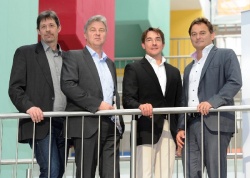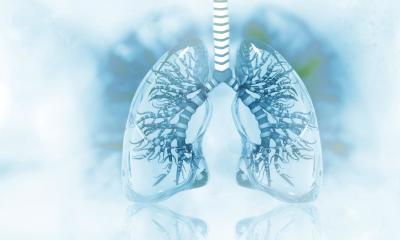The German Stem Cell Network
November’s successful first-year international gathering
More than 400 international scientists headed for the Max Delbrück Centre in Buch, near Berlin for updates on stem cell biology findings and discuss how to develop synergies between basic research, regenerative medicine and pharmacology, as well as strategies to cope better with researchers’ needs. The three-day event was the first annual conference of the German Stem Cell Network founded at the beginning of 2013.


In his opening remarks, Professor Oliver Brüstle, the then Acting President of the German Stem Cell Network (GSCN), outlined the importance of the foundation of this, as he called it, second-generation stem cell network. ‘The networks that were initiated ten years ago primarily had the mission to bring scientists together for the first time and thus create a stem cell community,’ he explained. Now, however, to justify the establishment of GSCN, the manifold requirements of this grown community must be channelled and managed, he added. The Network is funded by the Federal Ministry of Education and Research (BMBF) with around €300,000 for the initial yearlong phase.
The annual conference programme was pretty much structured by the contents, covered by the particular working parties of the GSCN. These fairly autonomous and self-reliant groups deal with purely scientific topics as well as strategic network interests. Among their main topics was pluripotency and stem cell re-programming.
Due to restrictions on human embryonic stem cell (hES) research – only the import but not the establishment of hES is allowed in Germany - many laboratories there pin their hope on the iPSCs research and the transdifferentiation technique. However, Prof. Frank Emmrich, member of the executive board of the GSCN, curbed expectations. ‘Nowadays nobody can say whether human embryonic stem cells are really dispensable.’ Hopefully in the next ten years, contrasting studies of human embryonic cells and iPSCs or transdifferentiated cells will reveal this
Other important topics were somatic stem cells and their development, stem cells in diseases such as cancer stem cells, stem cells in regenerative therapies and stem cells in disease modelling and drug development.
Prof. Brüstle gave a comparison of the strategic groups’ topics with those from already existing stem cell networks. ‘Our strategic groups are in charge of preparing better funding strategies, career development for our researchers, bundling information about clinical trials and regulatory affairs, outreach activities for teachers and scholars, patient information and stem cell technology development.’
The latter strategic group had the most registrations for stem cell technologies. Following the group’s first workshop at the annual conference, Prof. Frank Emmrich, one of two speakers from this group, said: ‘The need to obtain knowledge of new methods and of learning from the others seems to be enormous.’ Many participants in the predominantly young audience, he said, had pleaded to create an interactive internet platform in which to exchange competencies in stem cell technologies.
Other main technology needs were also discussed in this group – initially the development of a quick (within minutes) and reliable quality assurance tool for in vitro bred cell cultures to be injected into a patient by a medical practitioner for therapeutic purposes; then the need to learn more about the so-called stem cell niche - where stem cells are located in the body - and their micro-environment to enable a future reproduction of the niches and, consequently, of stem cells themselves in a bioreactor; and finally, the request for more cell culture media or nutrient solutions to raise stem cells. ‘The development of such cell culture media generally takes years, because so many unknown variables must be checked, but we hope we can find ways to accelerate the process using bio-infomatics instruments,’ Prof. Emmrich explained.
To hit all those goals the GSCN promotes close cooperation with the stem cell related industry, Prof. Brüstle pointed out. Consequently, the network also includes industry – currently five enterprises. However, the network is backed primarily by more than 250 personal memberships and six institutional memberships.
Apart from industry, the GSCN pursues a close exchange with other national and international stem cell research networks. All-in-all, this was notably accentuated by the four keynote lectures, given by distinguished stem cell researchers from abroad, including Prof. Michele De Luca from Italy, who presented his successful treatment of traumatic destruction of the conjunctival epithelium with cultured human limbal stem cells. Presently the GSCN is pursuing a second funding phase by the BMBF. Then, beyond 2017, the network will be run from membership fees.
Glossary
Induced pluripotent stem cells (iPSCs) – These are former adult cells, for example cells of the blood, liver, brain or pancreas that were re-programmed into their prior pluripotent condition aiming to turn them back into a wide variety of cells. In 2012, Prof. John B Gurdon, leader of the group Re-programming of Gene Expression by Nuclear Transfer at the Wellcome Trust/Cancer Research UK Gurdon Institute, part of Cambridge University, and Prof. Shinya Yamanaka, director of the Centre for iPS Cell Research and Application at Kyoto University, received the Nobel Prize in Physiology or Medicine for the discovery that mature cells can be reprogrammed to become pluripotent.
Transdifferentiation – The word describes the branch of research in which scientists try to bypass cell re-programming by directly programming one cell-type into another, as presented recently at the World Conference on Regenerative Medicine, in October in Leipzig), for example, for haematopoietic cells: somatic cells (fibroblasts) have been directly converted into primitive and mature haematopoietic cells by Dr Mick Bhatia from the McMaster Stem Cell and Cancer Research Institute (SCC-RI), in Canada.
Literature: Foundational concepts of cell fate conversion to the hematopoietic lineage. Salci KR, McIntyre BA, Bhatia M.: Curr. Opin. Genet. Dev. 2013 Oct; 23 (5): 585-90.
Profile:
Frank Emmrich MD is a clinical immunologist, specialist in cell biology, a professor at the Faculty of Medicine at the University of Leipzig, head of the Fraunhofer Institute for Cell Therapy and Immunology and also director of the Translational Centre for Regenerative Medicine (the latter two are Leipzig-based).
Along with management tasks, he researches tolerance induction; with his team he recently developed a method intended to avoid the Graft-versus-host disease in patients with allogeneic blood stem cell transplantation. With animal studies completed in 2013, as soon as financial support is assured, the technique will enter a clinical study.
Neuropathologist and specialist in stem cell research, Oliver Brüstle MD, directs the Institute of Reconstructive Neurobiology at the University of Bonn, and is scientific director of Life & Brain, a university-affiliated enterprise.
The professor’s research is dedicated to the use of pluripotent stem cells for neurogenerative diseases. He was an initiator and the Founding President of the German Stem Cell Network (GSCN) and is now succeeded Prof. Andreas Trumpp MD for the coming year.
Prof. Brüstle is also speaker for the Federal State of North Rhine Westphalia Stem Cell Network, founded a decade ago.
19.01.2014





